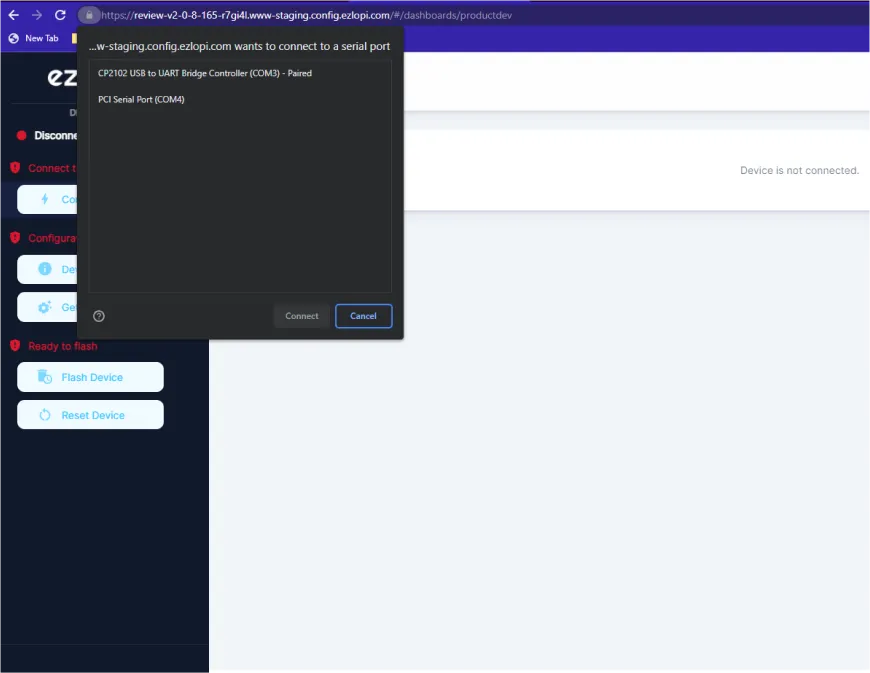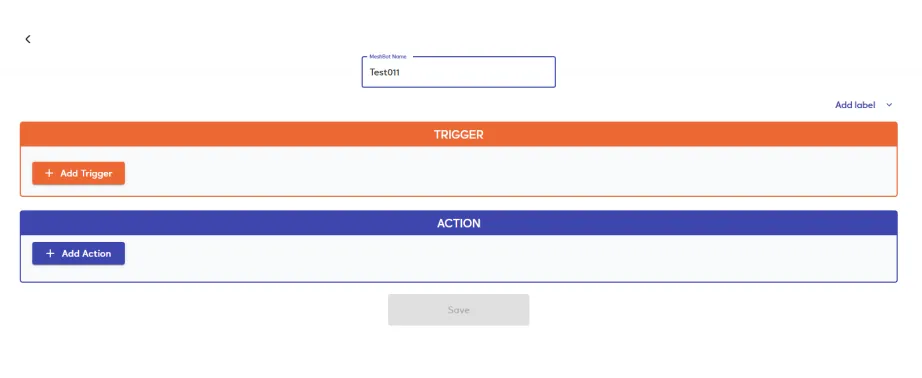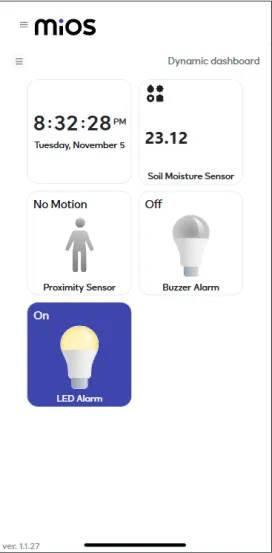
Innovation redefined with EzloPi
Object detection and soil monitoring
The EzloPi smart devices provide automation through simple, customizable use with our open-source EzloPi platform, making daily life easier and improving human-machine interactions.
Before moving into this example, it is very important to know about the device registration, provisioning and converting the ESP32 device into an EzloPi device along with knowledge of Web Flasher, MiOS Mobile Application for Android/iOS and the MiOS Web Application.
1. About this example
This project integrates object detection and soil monitoring using the EzloPi device. The capacitive soil moisture sensor module measures soil moisture levels, providing crucial data for automated irrigation and soil health monitoring. For object detection, the FC-51 proximity sensor module senses nearby objects, ideal for setting up alerts in restricted zones or detecting the presence of any animal or rodents. The MH-FMD buzzer serves as an alert system, sounding notifications for detected objects or specific soil moisture thresholds, enhancing both environmental monitoring and security applications. This setup offers a versatile solution for smart agriculture and safety systems.
2. Project Demonstration Video
Welcome to the project demonstration video section. The following video showcases the key aspects of Object detection and soil monitoring, providing a visual walkthrough of its implementation.
3. Circuit Diagram & Interface
The following components are required for interfacing with the EzloPi device:
- ESP32 as an EzloPi smart device.
- Capacitive soil moisture sensor module.
- FC-51 proximity sensor module.
- MH-FMD buzzer.
- LED with 100 Ohm resistor.
The wiring diagram of ESP32 30 pin is represented as follows:


The following connections are made in order to complete the circuit setup.
From ESP32 to the Soil Moisture Sensor:
| ESP32 | Soil Moisture Sensor |
| 3V3 | +(VCC) |
| GND | -(GND) |
| D33 | A |
From ESP32 to the FC-51 Proximity sensor:
| ESP32 | FC-51 Proximity Sensor |
| 3V3 | VCC |
| GND | GND |
| D15 | OUT |
From ESP32 to the LED & Resistor:
| ESP32 | LED | Resistor |
| GND | Cathode | - |
| D5 | - | Terminal 1 |
| - | Anode | Terminal 2 |
From ESP32 to the Buzzer:
| ESP32 | Buzzer |
| 3V3 | VCC |
| GND | GND |
| D4 | I/O |
4. Interfacing the Soil Moisture Sensor, Proximity Sensor and buzzer with EzloPi Web Flasher
1. Set up your device/hardware by visiting config.ezlopi.com

- Log in using the credentials which you just set earlier while signing up.

- Now, click on the Connect Device button and a pop-up window will appear.

- Now, select COM Port to which your ESP32 device is connected. In our case, the COM3 port is used.
Click Connect

- If you are new to this and it's your first time configuring, select Create new Device ID. Enter Wifi SSID and Wifi Password.
- In the Device Configuration, tab click on Analog Input.

- An Analog Input window will open for inputting the following parameters:
- Set a Device name of your choosing. In our case we set it to Soil Moisture Sensor.
- Set the Device Subtype to Soil Moisture Sensor.
- Set the ADC input pin to 33.
- Set the Resolution to 10-bit.
- Then Click Apply Button.
- In the Device Configuration, tab click on Digital Input.

- A Digital Input window will open for inputting the following parameters:
- Set a Device name of your choosing. In our case, we set it to Proximity Sensor.
- Set INPUT GPIO to 15.
- Set Device subtype to Proximity Sensor.
- Set Resistor to PULL DOWN.
- Then Click Apply Button.
- In the Device Configuration, tab click on Digital Output

- A Digital Output window will open for inputting the following parameters:
- Set a Device name of your choosing. In our case, we set it to Buzzer Alarm.
- Set Device subtype to LED.
- Set OUT GPIO to 4.
- Set Resistor to PULL UP.
- Then Click Apply Button.
- In the Device Configuration, tab click on Digital Output.

- A Digital Output window will open for inputting the following parameters:
- Set a Device name of your choosing. In our case, we set it to LED Alarm.
- Set Device subtype to LED.
- Set OUT GPIO to 5.
- Set Resistor to PULL UP.
- Then Click Apply Button.
- After clicking the apply button you can see a table of your setting in the device configuration tab.
- Press the Flash Device button.
- A window will appear on the bottom right side of the screen displaying “Please press BOOT button while flashing begins.”

- Hold the BOOT button down until the next window appears on the bottom right side of the screen which says “Installation prepared. Please release the boot button now.”

- Release the BOOT button from your ESP32 when this pop-up on the bottom right window appears.

- After some time, a popup will appear saying Device Flashed Successfully! This means that your device has been set up successfully.
5. MiOS Web Dashboard
- After configuring the controller with the EzloPi web flasher, head to ezlogic.mios.com

- Use the same credential to log in that you used for configuring the controller with the web flasher.

- On the MiOS web dashboard, you will be able to see the tiles for the soil moisture sensor, proximity sensor, buzzer alarm and LED alarm. The LED and buzzer alarms will indicate the status of soil moisture and proximity sensor values respectively.
MeshBots:

- On the left side of the screen under Automation, click on MeshBots.
- On meshbot screen, click on Create new MeshBot button present on the top right corner of the screen.
- After clicking on Create new MeshBot, you will see this now under Automation MeshBot click on Cloud.

- On the next screen you will see that we can create a name of our choosing, in this case we write it as Test011.

- In the trigger tab you can set the TRIGGER for your device and in the ACTION tab you can set the action to be performed based on the trigger which you have created.

- Set these things in TRIGGER section:
- Set Node Type to Device.
- Set the Node to Soil Moisture Sensor.
- Set the Capability to parent_abstract.
- Set the variables to uuid.
- Set the Comparator to Less (<).
- Set Value Type to value.
- Set the value to 25.
- Set these values in the TRUE part of the ACTION section.
- Set Controllable Type to Device.
- Set the Controllable to LED Alarm.
- Set the Capability to power_command.
- Set the Value Type to set.
- Set the Value to true.
- Now Click the Save button.

- After clicking the save button you can see this screen on the top right corner of the screen.

- Again Create new meshbot by clicking on Create new MeshBot you will see this now under Automation MeshBot click on Cloud.

- On the next screen you will see that we can create a name of our choosing, in this case we write it as Test012.

- In the trigger tab you can set the TRIGGER for your device and in the ACTION tab you can set the action to be performed based on the trigger which you have created.

- Set these things in TRIGGER section:
- Set Node Type to Device.
- Set the Node to Proximity Sensor.
- Set the Capability to motion_sensor.
- Set the variables to status.
- Set the Comparator to Equal(==).
- Set Value Type to value.
- Set the value to true.
- Set these values in the TRUE part of the ACTION section.
- Set Controllable Type to Device.
- Set the Controllable to Buzzer Alarm.
- Set the Capability to power_command.
- Set the Value Type to set.
- Set the Value to true.
- Now Click the Save button.

- After clicking the save button you can see this screen on the top right corner of the screen.

- Here you can see your saved MeshBot. Now click on Dashboard.

- In the MiOS web dashboard, you can see that when the soil moisture sensor detects a moisture value of less than 25, the LED alarm is turned ON because of the rules we have set in the meshbot.

- Here in the above scenario, the proximity sensor detects movement which is unauthorized and can be harmful to our crops or plants therefore the buzzer alarm is turned ON because of the rules we have set in the meshbot.
6. MiOS App
You can download the MIOS Android app from the Google Play Store and Apple App Store.
- After downloading the app, proceed to install the application and open it.

- Using the MIOS mobile application, create a new Ezlo Cloud account using the sign-up option. If you already have an account, you may proceed to log in.

- After successfully logging in, you will be able to see the number of controllers connected such as a lamp, fan, or any other device in the MiOS app. Tap on any controller of your desired ID:

- You will be able to see the status of your controller whether it is online or offline. Access the device dashboard, and tap the device. The following view of the dashboard will appear:

- In the MiOS mobile app, you can see that when the soil moisture sensor detects a moisture value of less than 25, the LED alarm is turned ON because of the rules we have set in the meshbot.

- Here in the above scenario, the proximity sensor detects movement which is unauthorized and can be harmful to our crops or plants therefore the buzzer alarm is turned ON because of the rules we have set in the meshbot.

eZlopie Products A single-channel 5V relay module $00.00

eZlopie Products Momentary switch $00.00

eZlopie Products Level Shifter Module (BSS138) $00.00

eZlopie Products ESP32
$00.00

eZlopie Products AC Lamp and Holder
$00.00












